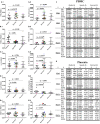First Trimester Pregnancy Loss and the Expression of Alternatively Spliced NKp30 Isoforms in Maternal Blood and Placental Tissue
- PMID: 26082773
- PMCID: PMC4450658
- DOI: 10.3389/fimmu.2015.00189
First Trimester Pregnancy Loss and the Expression of Alternatively Spliced NKp30 Isoforms in Maternal Blood and Placental Tissue
Abstract
Capsule: We observed that first trimester pregnancy loss is associated with an altered expression profile of the three isoforms of the NK receptor NKp30 expressed by NKs in PBMC and placental tissue. In this study, we aimed to investigate whether first trimester pregnancy loss is associated with differences in expression of NKp30 splice variants (isoforms) in maternal peripheral blood or placental tissue. We conducted a prospective case-control study; a total of 33 women undergoing dilation and curettage due to first trimester pregnancy loss were further subdivided into groups with sporadic or recurrent pregnancy loss. The control group comprises women undergoing elective termination of pregnancy. The qPCR approach was employed to assess the relative expression of NKp30 isoforms as well as the total expression of NKp30 and NKp46 receptors between the selected groups. Results show that in both PBMC and placental tissue, NKp46 and NKp30 expressions were mildly elevated in the pregnancy loss groups compared with the elective group. In particular, NKp46 elevation was significant. Moreover, expression analysis of NKp30 isoforms manifested a different profile between PBMC and the placenta. NKp30-a and NKp30-b isoforms in the placental tissue, but not in PBMC, showed a significant increase in the pregnancy loss groups compared with the elective group. Placental expression of NKp30 activating isoforms-a and -b in the pregnancy loss groups was negatively correlated with PLGF expression. By contrast, placental expression of these isoforms in the elective group was positively correlated with TNFα, IL-10, and VEGF-A expression. The altered expression of NKp30 activating isoforms in placental tissue from patients with pregnancy loss compared to the elective group and the different correlations with cytokine expression point to the involvement of NKp30-mediated function in pregnancy loss.
Keywords: NCR; NKp30; isoforms; natural killer; pregnancy loss.
Figures




References
LinkOut - more resources
Full Text Sources
Other Literature Sources

